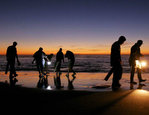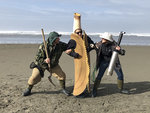

Razor clam harvesters will be unleashed for a week-long set of digs on at least two Washington coast beaches beginning on Saturday, Oct. 26.
That news was handed down by the Washington Department of Fish and Wildlife on Tuesday afternoon as succulent bivalve lovers began to grow anxious over the status of those proposed digging dates. Results of precautionary marine toxin tests paved the way for the 7-day opening of Mocrocks and Copalis beaches. However, additional testing will be required at Long Beach and Twin Harbors before those locations are given the go-ahead for razor clam harvesting. Final word is expected to be announced by the WDFW on Friday.
"In the last few days, we've seen increasing levels of the algae that can cause domoic acid in ocean water at Long Beach and Twin Harbors," explained Dan Ayres, WDFW coastal shellfish manager, in a press release. "Our first priority is safety, and we, working alongside the Department of Health, are reserving judgment on opening of these areas in order to ensure safety for all those who enjoy this activity."
Oceanic models show that a “blob” of warm water may be fixing to settle in off of Washington’s coast. The last time that happened, in 2013-14, ocean conditions were thrown into disorder and a persistent bout of domoic acid cancelled razor clam digs up and down the coast. Domic acid is a naturally occurring toxin that can cause severe illness or death in humans who consume it.
Domic acid levels were observed to be on the rise on the state’s southernmost ocean beaches. However, both Copalis and Mocrocks returned clean samples that indicate the clams will be safe for human consumption.
“Razor clam digs are a major source of livelihood for coastal communities, bringing out hundreds of thousands of tourists each year to enjoy all we have to offer, including terrific nature, food, entertainment and fun on the beach for the whole family,” said Andi Day, Executive Director at Long Beach Peninsula Visitors Bureau, in the release. “We value and appreciate WDFW’s work to manage this terrific resource for our communities.”
Upcoming digs are approved for the following dates, low tides, and beaches:
October 26, Saturday, 5:59 pm, 0.0 feet; Copalis
October 27, Sunday, 6:47 pm, -0.8 feet; Mocrocks
October 28, Monday, 7:33 pm, -1.2 feet; Copalis
October 29, Tuesday, 8:18 pm, -1.4 feet; Mocrocks
October 30, Wednesday, 9:03 pm, -1.2 feet; Copalis
October 31, Thursday, 9:50 pm, -0.8 feet; Mocrocks
November 1, Friday, 10:38 pm, -0.2 feet; Copalis
No digging is allowed before noon on open beaches. Ayres always recommends that diggers arrive an hour or two prior to low tide in order to find the best digging conditions.
“Diggers want to be sure to come prepared with good lighting devices and always keep an eye on the surf, particularly at this time of year when low tides come at dusk and after dark,” noted Ayres.
Additional clam digging dates have been proposed through the end of the year. Approval of those digs will be dependent upon marine toxin tests conducted closer to those particular dates.
All clam diggers age over the age of 14 are required to possess an valid fishing license. State law allows each digger to harvest up to 15 clams per day, but they must keep the first 15 they dig regardless of size or condition. Additionally, clams must be kept in personal containers.